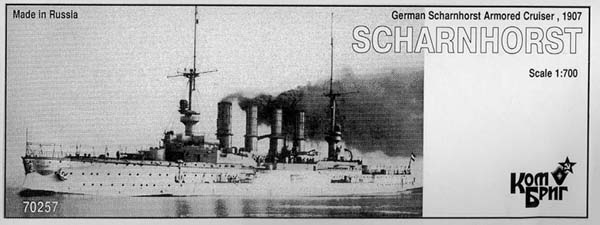
Reviewed by Timothy Dike

| The Scharnhorst was an armored cruiser
built in 1906. Weighing in at 11,600 tons and armed with eight 8.2"
(21 cm) and six 5.9" (15 cm) guns she was a formidable ship. But
newer classes of ships then entering service were faster heavier armed
and Scharnhorst and sistership Gneisenau were now outclassed. The ships
found themselves assigned to Germany's East Asiatic squadron and operated
out of Tsingtao, China.
When world war one broke out Scharnhorst and Gneisenau were sent to Samoa to investigate the takeover of that German colony. The ships bombarded the colony and sank a the French gunboat Zélée. The ships next sailed for Easter Islands and on to the coast of Chile where they met up with the British at what would come to be known as the Battle of Coronel. On November 1st the HMS Good Hope, Monmouth, Otranto and Glasgow encountered the two ships and light cruisers Nürnberg, Dresden and Leipzig. Scharnhorst put 35 shells into the Good Hope, one of which penetrated her magazine and she went up in a huge fireball. Monmouth was next and she later rolled over and sank. 1,600 British sailors were lost and the Royal Navy set out to hunt down the German fleet. They got their chance when the Germans sailed into Port Stanley intent on destroying the wireless transmitter there. They found the harbor occupied by a force of Battlecruisers Invincible and Inflexible and several light cruiser. Outnumbered and out gunned the German ships retreated. The British ships quickly built up steam and set out in pursuit. They caught up to the two armored cruisers and their light cruiser and engaged them at range. Knowing that the end was near the Scharnhorst and Gneisenau turned and closed the range in an attempt to let the light cruisers escape. The ships started taking hits and the Scharnhorst was on reported burning with her number three funnel down taking on water. She rolled over and sank 45 minutes later with all hands lost. One after the others the German ships were sank with only Nürnberg escaping, if only for a time. The British ships Kent and Glasgow found her in Cumberland Bay, off the coast of Chile. The German crew scuttled the ship rather than let her fall into British hands. The loss was the end for the East Asiatic squadron. Combrig has produced this important German ship in her as built configuration. |
|||||||||||||||||||||
| HULL | |||||||||||||||||||||
| The hull on this ship is exceptionally well cast with well defined shapes and fine deck planking. The hull sides are well done with a nice gradual rounding that tapers down toward the bow. The barrettes for the secondary guns are nicely done and there are no signs of mold tearing around the complex shapes. The funnel locations are hollowed out and once you clean the little bit of flash on these parts, you will be amazed at how well they fit. Chock and bits around the deck edge are well cast and there will be next to no cleanup needed on this kit. |
to enlarge |
||||||||||||||||||||
|
|||||||||||||||||||||
| SUPERSTRUCTURE AND DETAILS | |||||||||||||||||||||
| The bridge and platforms are cast on a thin resin wafer and you will need to do a little flat sanding to remove it. Fortunately it is very thin and this should not be difficult. The funnels are cast with the base and vents in a single piece. These are very well done and fit tightly into the sockets on the deck. |  |
||||||||||||||||||||
|
|||||||||||||||||||||
| WEAPONS | |||||||||||||||||||||
| The two main gun turrets are well cast with separate resin barrels. The light guns are cast with a separate base and barrel. Barrels are provided for the casemate guns as well. Modelers may wish to upgrade these with the replacement brass barrels from the aftermarket companies. |  |
||||||||||||||||||||
|
|||||||||||||||||||||
| SHIPS BOATS AND SMALL FITTINGS | |||||||||||||||||||||
| The ships boats are very finely cast with lots of detail inside and out. The anchors, cable reels, and searchlights are among the other parts cast in resin. All well detailed. | |||||||||||||||||||||
|
|||||||||||||||||||||
| PHOTO ETCH | |||||||||||||||||||||
| A brass photo etch fret is provided with platform braces and latticework. Gun shields for the light guns and even a ships crest are provided. | |||||||||||||||||||||
| INSTRUCTIONS | |||||||||||||||||||||
The instructions consist of a plan and elevations with
rigging shown on page one, and an exploded view of the assembly on page
two. This is the weak point of the kit. More sub assembly views would have
been helpful here.
|
|||||||||||||||||||||
| CONCLUSIONS | |||||||||||||||||||||

This is a well engineered kit and a perfect start to build your East Asiatic squadron. The casting is first rate and the parts are highly detailed. This kit is listed on the Pacific Front Hobbies website for $55.00 (US), a fantastic price for a ship of this size. |
|||||||||||||||||||||
